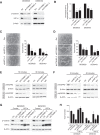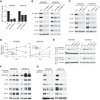PDGFRβ Signaling Cooperates with β-Catenin to Modulate c-Abl and Biologic Behavior of Desmoid-Type Fibromatosis
- PMID: 37943631
- PMCID: PMC10792363
- DOI: 10.1158/1078-0432.CCR-23-2313
PDGFRβ Signaling Cooperates with β-Catenin to Modulate c-Abl and Biologic Behavior of Desmoid-Type Fibromatosis
Abstract
Purpose: This study sought to identify β-catenin targets that regulate desmoid oncogenesis and determine whether external signaling pathways, particularly those inhibited by sorafenib (e.g., PDGFRβ), affect these targets to alter natural history or treatment response in patients.
Experimental design: In vitro experiments utilized primary desmoid cell lines to examine regulation of β-catenin targets. Relevance of results was assessed in vivo using Alliance trial A091105 correlative biopsies.
Results: CTNNB1 knockdown inhibited hypoxia-regulated gene expression in vitro and reduced levels of HIF1α protein. ChIP-seq identified ABL1 as a β-catenin transcriptional target that modulated HIF1α and desmoid cell proliferation. Abrogation of either CTNNB1 or HIF1A inhibited desmoid cell-induced VEGFR2 phosphorylation and tube formation in endothelial cell co-cultures. Sorafenib inhibited this activity directly but also reduced HIF1α protein expression and c-Abl activity while inhibiting PDGFRβ signaling in desmoid cells. Conversely, c-Abl activity and desmoid cell proliferation were positively regulated by PDGF-BB. Reduction in PDGFRβ and c-Abl phosphorylation was commonly observed in biopsy samples from patients after treatment with sorafenib; markers of PDGFRβ/c-Abl pathway activation in baseline samples were associated with tumor progression in patients on the placebo arm and response to sorafenib in patients receiving treatment.
Conclusions: The β-catenin transcriptional target ABL1 is necessary for proliferation and maintenance of HIF1α in desmoid cells. Regulation of c-Abl activity by PDGF signaling and targeted therapies modulates desmoid cell proliferation, thereby suggesting a reason for variable biologic behavior between tumors, a mechanism for sorafenib activity in desmoids, and markers predictive of outcome in patients.
©2023 The Authors; Published by the American Association for Cancer Research.
Figures





References
-
- Fiore M, Rimareix F, Mariani L, Domont J, Collini P, Le Pechoux C, et al. Desmoid-type fibromatosis: a front-line conservative approach to select patients for surgical treatment. Ann Surg Oncol 2009;16:2587–93. - PubMed
-
- Colombo C, Fiore M, Grignani G, Tolomeo F, Merlini A, Palassini E, et al. A prospective observational study of active surveillance in primary desmoid fibromatosis. Clin Cancer Res 2022;28:4027–32. - PubMed
Publication types
MeSH terms
Substances
Grants and funding
LinkOut - more resources
Full Text Sources
Molecular Biology Databases
Miscellaneous

